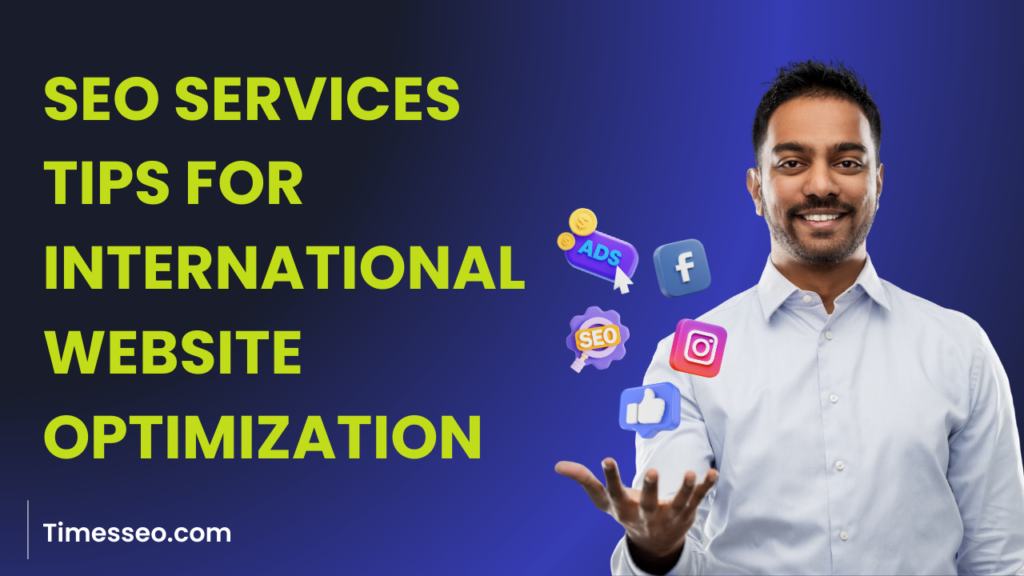
SEO Services Tips for International Website Optimization
Discover essential SEO services tips to boost your international website’s visibility and reach. Learn how to optimize for multiple countries, localize content, improve technical SEO, and target global audiences effectively.
Table of Contents
Introduction
What is International SEO?
The act of optimizing your website so that search engines can quickly determine which languages you employ and which countries you wish to target is known as international SEO. Think of it as giving your site a “global passport” — it helps you enter multiple markets smoothly without getting lost in translation.
Why International SEO Matters for Businesses
International SEO is crucial if your company has the potential to service clients outside of your country. It ensures your products or services appear in front of the right audience, in the right country, and in the right language.
Understanding Target Markets
Identifying Potential International Audiences
Before going global, you must know where your audience is. Use tools like Google Analytics and SEMrush to identify traffic sources and potential demand in different regions.
Cultural and Linguistic Differences in SEO
Keywords and content that work in one country may flop in another. For example, in the UK, a “jumper” refers to a sweater, while in the US, it means a dress. Cultural context shapes search behavior.
Website Structure for International SEO
ccTLDs vs. Subdomains vs. Subdirectories
- ccTLDs (country code top-level domains) like .fr or .de give strong location signals but require more resources.
- Subdomains (fr.example.com) are easier to set up but weaker for geo-targeting.
- Subdirectories (example.com/fr/) are cost-effective and easier to maintain.
Implementing hreflang Tags Correctly
Using hreflang tags, search engines may determine a page’s location and language. Misplacing or skipping them can confuse Google and lower rankings.
Keyword Research for Global Markets
Localizing Keywords for Different Languages
Don’t just translate keywords — localize them. For example, “car rental” in the US might be “car hire” in the UK. Use keyword research tools specific to each country.
Understanding Search Intent Across Cultures
In some regions, users prefer direct purchase, while others value extensive research before buying. Tailor your keywords accordingly.
Content Localization and Translation
Avoiding Direct Translation Mistakes
Literal translations can harm credibility. “Come alive with the Pepsi Generation,” for example, was mistranslated as “Pepsi brings your ancestors back from the grave” in China.
Using Native Speakers for Content Creation
Native writers understand slang, idioms, and cultural nuances, ensuring content feels authentic to the audience.
Technical SEO for International Websites
Page Speed Optimization for Global Users
Use a CDN (Content Delivery Network) to serve content quickly across continents. Page load speed affects rankings and conversions.
Mobile-First Indexing in Global Markets
With mobile usage dominating globally, ensure your site is responsive and loads well even on slower connections.
Link Building Strategies for International SEO
Acquiring Local Backlinks
Collaborate with local bloggers, news outlets, and business directories to build high-quality, country-specific backlinks.
Building Relationships with Regional Influencers
Influencer marketing is powerful — but influencers must be relevant to the local market, not just globally popular.
Leveraging Social Media for International Reach
Choosing Platforms Popular in Target Countries
Facebook may dominate in some countries, while WeChat, VK, or LINE lead in others. Know where your audience spends time.
Localized Social Media Campaigns
Create campaigns that reflect local trends, holidays, and humor for better engagement.
Monitoring and Measuring International SEO Success
Using Google Search Console for Multiple Countries
Set up country-specific properties to monitor performance and troubleshoot issues for each target market.
Analyzing Regional Analytics Data
Segment your analytics by region and language to see what’s working and where adjustments are needed.
Common Mistakes in International SEO and How to Avoid Them
- Using machine translation without review.
- Ignoring cultural context.
- Not setting up hreflang properly.
- Hosting all content in one location without a CDN.
- Applying one-size-fits-all SEO strategies.
Conclusion
International SEO is not just about ranking globally — it’s about connecting with diverse audiences on their terms. By investing in proper keyword research, cultural adaptation, technical optimization, and local outreach, you can open your business to a world of opportunities.
Frequently Asked Questions
Targeting the right audience with localized keywords and content tailored to their culture.
Not always — subdirectories or subdomains can work if optimized correctly.
No, always use professional translators or native speakers for accuracy.
It depends on competition, but typically 3–6 months for noticeable results.
Yes, localized social media campaigns can boost visibility and engagement in new market
Table of Contents
Popular Posts
-
 Affordable Technical SEO Audit for Small Business: A Complete Guide26 Jun 2025 Blog
Affordable Technical SEO Audit for Small Business: A Complete Guide26 Jun 2025 Blog -
 How to Get an Affordable Technical SEO Audit for Small Business27 Jun 2025 Blog
How to Get an Affordable Technical SEO Audit for Small Business27 Jun 2025 Blog -
 The Ultimate Local SEO Audit Checklist for Startups28 Jun 2025 Blog
The Ultimate Local SEO Audit Checklist for Startups28 Jun 2025 Blog -
 Local SEO Audit Checklist for Startups: A Beginner’s Guide28 Jun 2025 Blog
Local SEO Audit Checklist for Startups: A Beginner’s Guide28 Jun 2025 Blog -
 Top On-Page SEO Audit Steps for Service Websites Every Business Should Know29 Jun 2025 Blog
Top On-Page SEO Audit Steps for Service Websites Every Business Should Know29 Jun 2025 Blog -
 Technical SEO for WordPress: The Ultimate Beginner’s Guide01 Jul 2025 Blog
Technical SEO for WordPress: The Ultimate Beginner’s Guide01 Jul 2025 Blog -
 The Impact of On-Page SEO Audit Steps for Service Websites on UX01 Jul 2025 Blog
The Impact of On-Page SEO Audit Steps for Service Websites on UX01 Jul 2025 Blog -
 Technical Mobile SEO Audit Tips for Developers02 Jul 2025 Blog
Technical Mobile SEO Audit Tips for Developers02 Jul 2025 Blog -
 Complete SEO Backlink Audit Guide for Better Google Rankings03 Jul 2025 Blog
Complete SEO Backlink Audit Guide for Better Google Rankings03 Jul 2025 Blog -
 Boost Your Rankings with Technical SEO for WordPress01 Jul 2025 Blog
Boost Your Rankings with Technical SEO for WordPress01 Jul 2025 Blog






